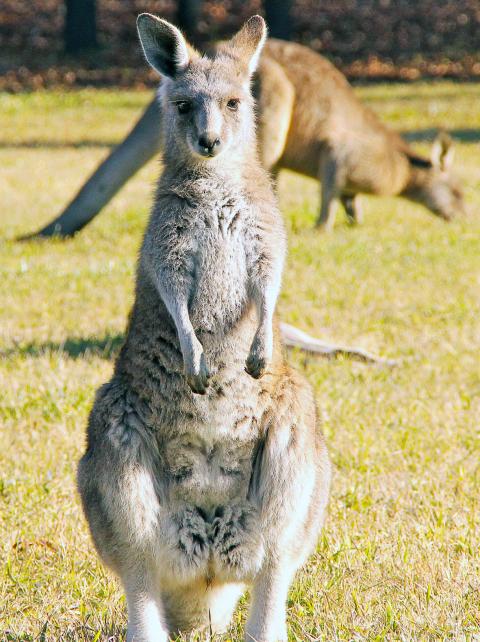At the Purple Goanna cafe in inner-city Sydney, a fillet of crocodile was slowly poaching in a wattle seed cream sauce.
“Previously, I had only tasted crocodile that had been fried, and it was really tough and chewy. But if you poach it slowly it’s very tender, similar to chicken,” said Taryn Stewart, 25, who has worked at the cafe for six months. The Purple Goanna specializes in fusing traditional Aboriginal meats and spices with modern cuisine.
Stewart’s favorite dish is kangaroo steak. “You’ve got to cook it fast so it’s really tender and not tough and chewy, which means just a couple of minutes on each side,” she said.

Photo: AFP
But she will not be standing over the grill here for much longer. This month Stewart, with 17 other trainees, is beginning an indigenous chef traineeship — the first of its kind — with some of Sydney’s leading restaurateurs. She hopes to have her own restaurant one day.
Neil Perry owns Sydney’s Rockpool restaurant and will be one of the program’s mentors.
“When you think of all the fantastic chefs in Australia, there aren’t really any indigenous ones at the top of the tree,” he said.
“We’d like to think that one day there will be a great contribution to the Australian culinary scene by young indigenous people.”
Perry is one of 13 high-profile chefs from Sydney who will take on indigenous trainees for three years.
“The exciting thing is the influence we can have on the trainees, so one day one of them might run their own kitchen and be able to reflect on their indigenous cooking and ingredients and bring that into their food,” he said.
Each trainee and their new employers will be mentored by respected Aboriginal figures in the community throughout the traineeship. The scheme is backed by private donors and the federal government’s indigenous employment program.
“Employment is the best way to close the gap on indigenous inequality and giving a person a job not only changes their lives, but the lives of their family and friends,” said Mark Arbib, a former federal minister for indigenous employment who is involved with the trainee scheme.
“A lot of work is under way to address the employment differences between indigenous and non-indigenous communities, but it’s going to take decades to turn it around.”
Less than half of Australia’s indigenous students finish high school, compared with 88 percent of the non-indigenous population. Unemployment is four times the national average and the average weekly wage of indigenous people is a third less than that of other Australians.
“The government can’t do it alone and private industry needs to get involved. A project like this is great because small business people are getting off their backsides and putting their shoulders to the wheel to actually fight indigenous inequality,” said Arbib.
The scheme will initially only operate in Sydney but the backers hope that it will eventually expand around the country.
At the Purple Goanna, Stewart said her excitement about the course was mixed with trepidation. “I’m a bit terrified to be trained by such well-known chefs but I do think we definitely need indigenous role models in this industry,” she said.

That US assistance was a model for Taiwan’s spectacular development success was early recognized by policymakers and analysts. In a report to the US Congress for the fiscal year 1962, former President John F. Kennedy noted Taiwan’s “rapid economic growth,” was “producing a substantial net gain in living.” Kennedy had a stake in Taiwan’s achievements and the US’ official development assistance (ODA) in general: In September 1961, his entreaty to make the 1960s a “decade of development,” and an accompanying proposal for dedicated legislation to this end, had been formalized by congressional passage of the Foreign Assistance Act. Two

Despite the intense sunshine, we were hardly breaking a sweat as we cruised along the flat, dedicated bike lane, well protected from the heat by a canopy of trees. The electric assist on the bikes likely made a difference, too. Far removed from the bustle and noise of the Taichung traffic, we admired the serene rural scenery, making our way over rivers, alongside rice paddies and through pear orchards. Our route for the day covered two bike paths that connect in Fengyuan District (豐原) and are best done together. The Hou-Feng Bike Path (后豐鐵馬道) runs southward from Houli District (后里) while the

March 31 to April 6 On May 13, 1950, National Taiwan University Hospital otolaryngologist Su You-peng (蘇友鵬) was summoned to the director’s office. He thought someone had complained about him practicing the violin at night, but when he entered the room, he knew something was terribly wrong. He saw several burly men who appeared to be government secret agents, and three other resident doctors: internist Hsu Chiang (許強), dermatologist Hu Pao-chen (胡寶珍) and ophthalmologist Hu Hsin-lin (胡鑫麟). They were handcuffed, herded onto two jeeps and taken to the Secrecy Bureau (保密局) for questioning. Su was still in his doctor’s robes at

Mirror mirror on the wall, what’s the fairest Disney live-action remake of them all? Wait, mirror. Hold on a second. Maybe choosing from the likes of Alice in Wonderland (2010), Mulan (2020) and The Lion King (2019) isn’t such a good idea. Mirror, on second thought, what’s on Netflix? Even the most devoted fans would have to acknowledge that these have not been the most illustrious illustrations of Disney magic. At their best (Pete’s Dragon? Cinderella?) they breathe life into old classics that could use a little updating. At their worst, well, blue Will Smith. Given the rapacious rate of remakes in modern